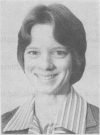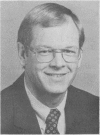Abstract
The purpose of this study was to investigate the effect of physical conditioning on the rate of blood lactate disappearance during recovery from supramaximal exercise. The rate of blood lactate disappearance was determined in 11 female and 4 male subjects before and after a 6-week conditioning programme. Blood samples were taken during the 30 minutes following supramaximal exercise during both passive (resting) and active recoveries. Pre-test active recovery was performed at 25% VO2 max; post-test active recovery was performed at both the same absolute and relative intensities (% VO2 max) as during the pre-test. Eight of the subjects trained 4 days/week for 6 weeks with high-intensity interval bicycle ergometer exercise, and 7 subjects served as controls. The conditioning programme significantly (p less than .05) increased VO2 max by 6.7 ml/kg.min (15%) and work capacity on the cycle ergometer by 2.8 minutes (27%). Physical conditioning did not affect significantly (p less than .05) the rate of blood lactate disappearance measured during passive recovery or during active recovery at the same absolute intensity, but increased significantly (p less than .05) the rate of blood lactate disappearance during active recovery performed at the same relative exercise intensity. The increased disappearance rate following conditioning was attributed to the higher absolute intensity of recovery work performed.
Full text
PDF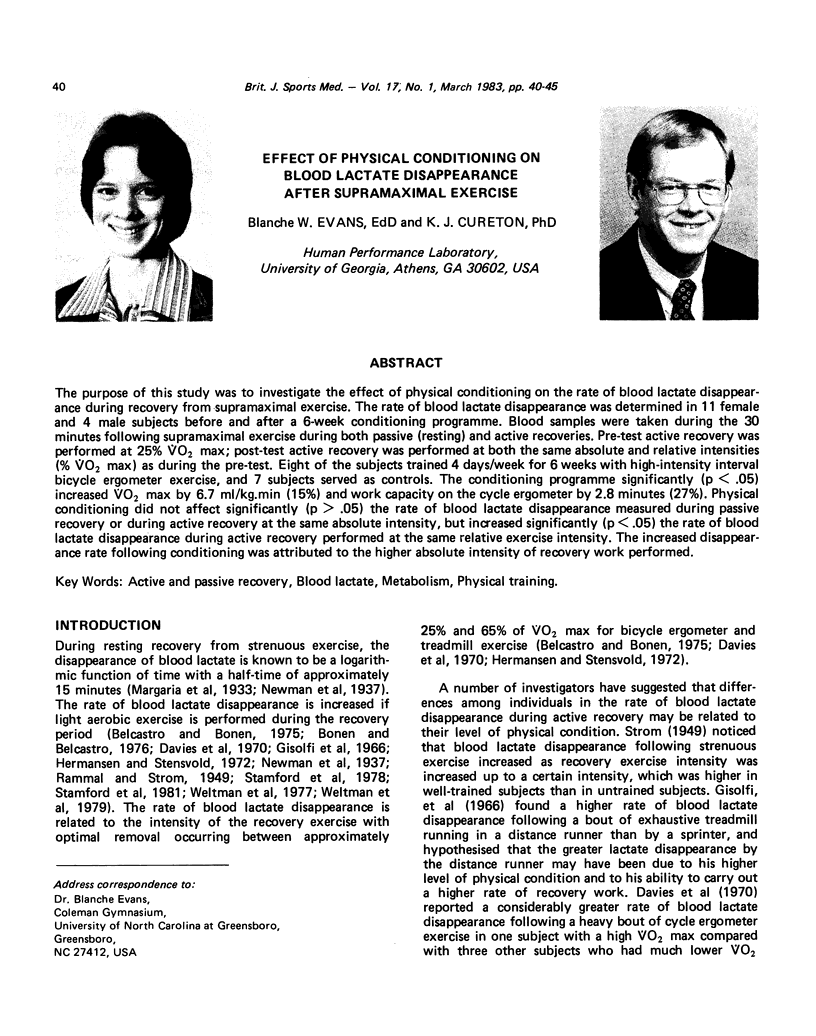
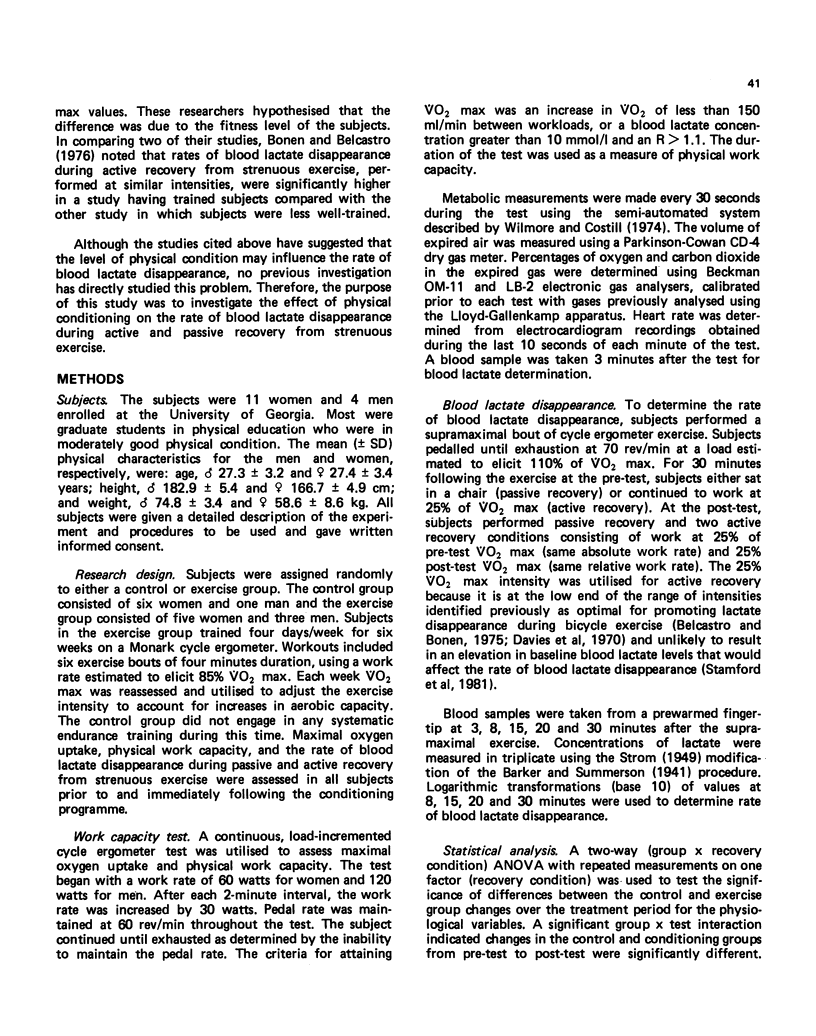
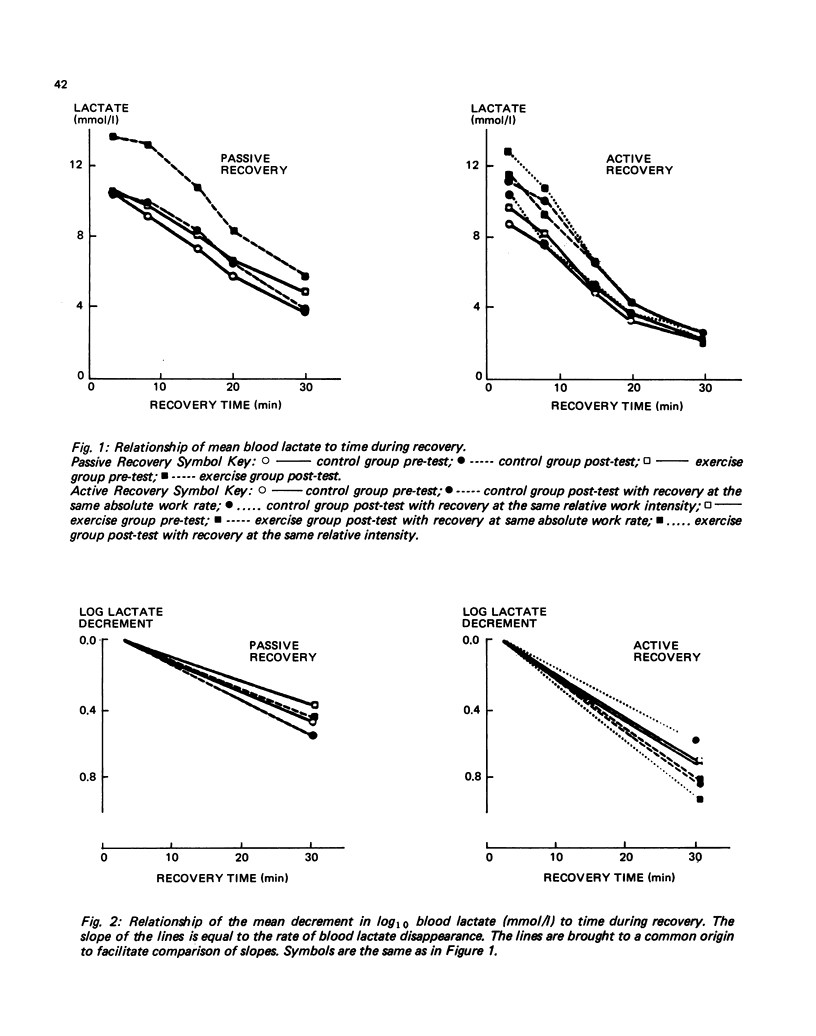
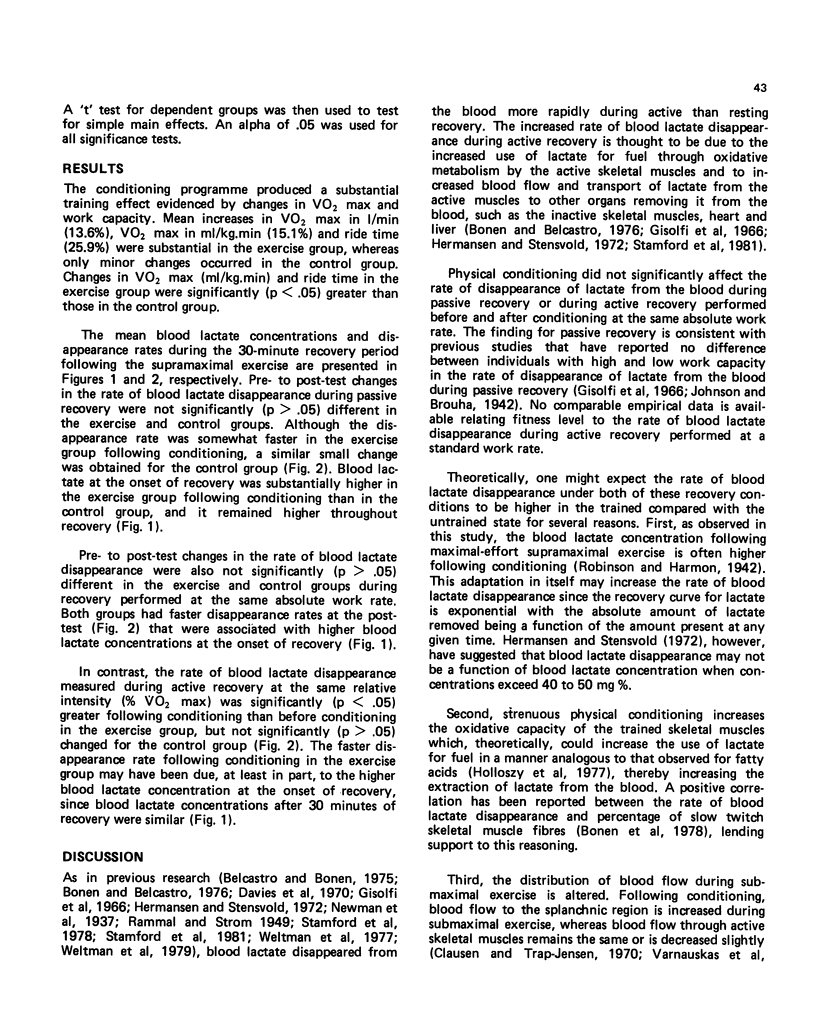
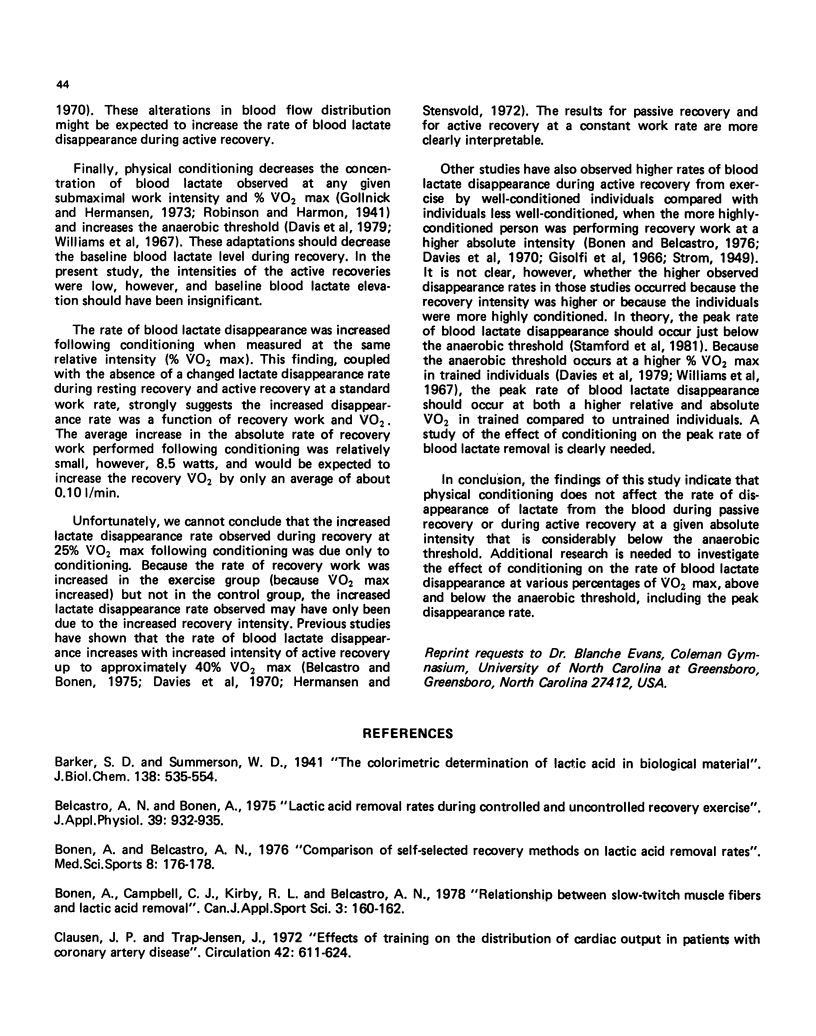
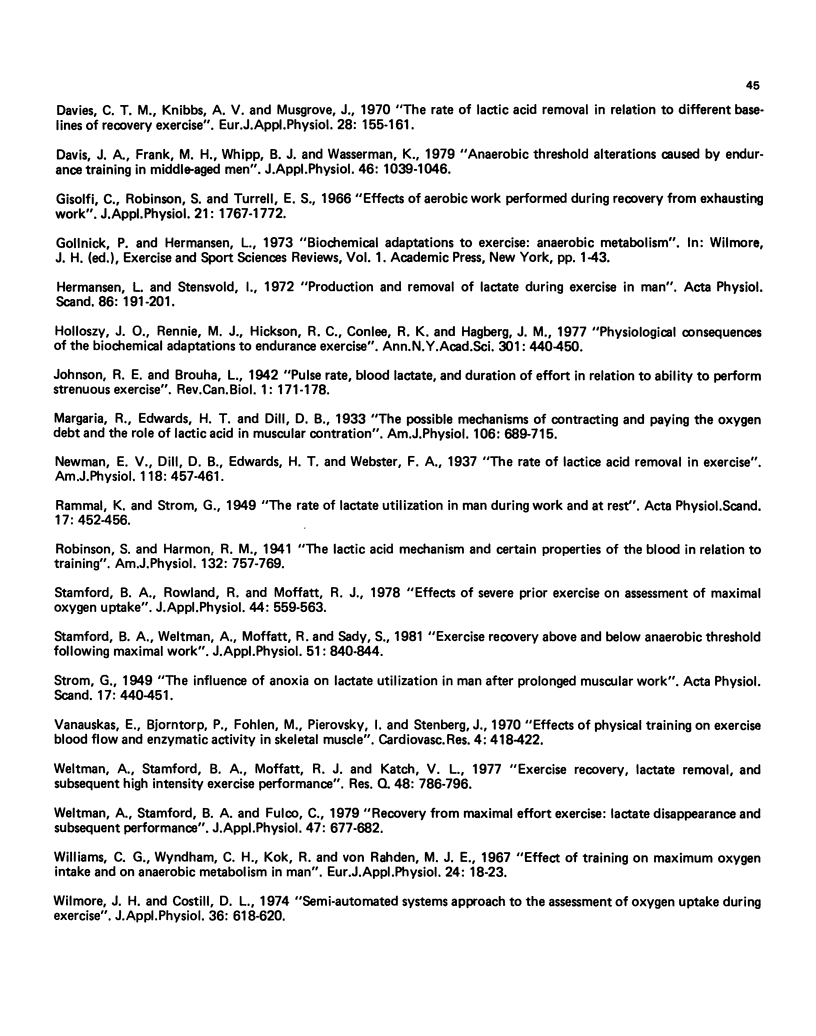
Images in this article
Selected References
These references are in PubMed. This may not be the complete list of references from this article.
- Belcastro A. N., Bonen A. Lactic acid removal rates during controlled and uncontrolled recovery exercise. J Appl Physiol. 1975 Dec;39(6):932–936. doi: 10.1152/jappl.1975.39.6.932. [DOI] [PubMed] [Google Scholar]
- Bonen A., Belcastro A. N. Comparison of self-selected recovery methods on lactic acid removal rates. Med Sci Sports. 1976 Fall;8(3):176–178. doi: 10.1249/00005768-197600830-00008. [DOI] [PubMed] [Google Scholar]
- Clausen J. P., Trap-Jensen J. Effects of training on the distribution of cardiac output in patients with coronary artery disease. Circulation. 1970 Oct;42(4):611–624. doi: 10.1161/01.cir.42.4.611. [DOI] [PubMed] [Google Scholar]
- Davies C. T., Knibbs A. V., Musgrove J. The rate of lactic acid removal in relation to different baselines of recovery exercise. Int Z Angew Physiol. 1970;28(3):155–161. doi: 10.1007/BF00696023. [DOI] [PubMed] [Google Scholar]
- Davis J. A., Frank M. H., Whipp B. J., Wasserman K. Anaerobic threshold alterations caused by endurance training in middle-aged men. J Appl Physiol Respir Environ Exerc Physiol. 1979 Jun;46(6):1039–1046. doi: 10.1152/jappl.1979.46.6.1039. [DOI] [PubMed] [Google Scholar]
- Gisolfi C., Robinson S., Turrell E. S. Effects of aerobic work performed during recovery from exhausting work. J Appl Physiol. 1966 Nov;21(6):1767–1772. doi: 10.1152/jappl.1966.21.6.1767. [DOI] [PubMed] [Google Scholar]
- Gollnick P. D., Hermansen L. Biochemical adaptations to exercise: anaerobic metabolism. Exerc Sport Sci Rev. 1973;1:1–43. [PubMed] [Google Scholar]
- Hermansen L., Stensvold I. Production and removal of lactate during exercise in man. Acta Physiol Scand. 1972 Oct;86(2):191–201. doi: 10.1111/j.1748-1716.1972.tb05325.x. [DOI] [PubMed] [Google Scholar]
- Holloszy J. O., Rennie M. J., Hickson R. C., Conlee R. K., Hagberg J. M. Physiological consequences of the biochemical adaptations to endurance exercise. Ann N Y Acad Sci. 1977;301:440–450. doi: 10.1111/j.1749-6632.1977.tb38220.x. [DOI] [PubMed] [Google Scholar]
- Stamford B. A., Rowland R., Moffatt R. J. Effects of severe prior exercise on assessment of maximal oxygen uptake. J Appl Physiol Respir Environ Exerc Physiol. 1978 Apr;44(4):559–563. doi: 10.1152/jappl.1978.44.4.559. [DOI] [PubMed] [Google Scholar]
- Stamford B. A., Weltman A., Moffatt R., Sady S. Exercise recovery above and below anaerobic threshold following maximal work. J Appl Physiol Respir Environ Exerc Physiol. 1981 Oct;51(4):840–844. doi: 10.1152/jappl.1981.51.4.840. [DOI] [PubMed] [Google Scholar]
- Varnauskas E., Björntorp P., Fahlén M., Prerovský I., Stenberg J. Effects of physical training on exercise blood flow and enzymatic activity in skeletal muscle. Cardiovasc Res. 1970 Oct;4(4):418–422. doi: 10.1093/cvr/4.4.418. [DOI] [PubMed] [Google Scholar]
- Weltman A., Stamford B. A., Fulco C. Recovery from maximal effort exercise: lactate disappearance and subsequent performance. J Appl Physiol Respir Environ Exerc Physiol. 1979 Oct;47(4):677–682. doi: 10.1152/jappl.1979.47.4.677. [DOI] [PubMed] [Google Scholar]
- Weltman A., Stamford B. A., Moffatt R. J., Katch V. L. Exercise recovery, lactate removal, and subsequent high intensity exercise performance. Res Q. 1977 Dec;48(4):786–796. [PubMed] [Google Scholar]
- Williams C. G., Wyndham C. H., Kok R., von Rahden M. J. Effect of training on maximum oxygen intake and on anaerobic metabolism in man. Int Z Angew Physiol. 1967;24(1):18–23. doi: 10.1007/BF00693572. [DOI] [PubMed] [Google Scholar]
- Wilmore J. H., Costill D. L. Semiautomated systems approach to the assessment of oxygen uptake during exercise. J Appl Physiol. 1974 May;36(5):618–620. doi: 10.1152/jappl.1974.36.5.618. [DOI] [PubMed] [Google Scholar]



